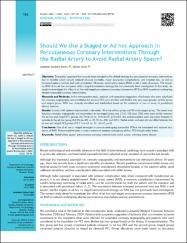Should we use a staged or ad hoc approach in percutaneous coronary interventions through the radial artery to avoid radial artery spasm?

Göster/
Erişim
info:eu-repo/semantics/openAccessAttribution 4.0 Internationalhttps://creativecommons.org/licenses/by/4.0/legalcodeTarih
2020Üst veri
Tüm öğe kaydını gösterKünye
Demir, G. G. ve Güler, E. (2020). Should we use a staged or ad hoc approach in percutaneous coronary interventions through the radial artery to avoid radial artery spasm? Erciyes Medical Journal, 42(2), 139-142. https://dx.doi.org/10.14744/etd.2020.94752Özet
Objective: Transradial approach has recently been adopted as the default strategy for percutaneous coronary interventions due to benefits which include reduced all-cause mortality, major access-site complications, and hospital stay, as well as increased patient comfort and early ambulation. However, radial artery spasm (RAS) is still a major drawback. The impact on RAS of an ad hoc compared with a staged intervention strategy has not previously been investigated. In this study, we sought to investigate the effect of ad hoc and staged percutaneous coronary intervention (PCI) on RAS in patients undergoing elective transradial coronary interventions. Materials and Methods: In this retrospective study, patients with symptoms suggestive of ischemia who were scheduled for coronary angiography and candidates for elective PCI were enrolled and divided into two equal groups: ad hoc group and staged group. RAS was clinically identified and established based on the existence of two or more of predefined clinical features. Results: A total of 60 patients was enrolled in the study: 30 in the ad hoc group and 30 in the staged group. The mean time between coronary angiography and intervention in the staged group was 2.5 [1–30] days. RAS rates were similar between the ad hoc and staged PCI groups (16.7% [n=5] vs. 31% [n=9], p=0.233), but post-procedural pain was more frequent in patients in the ad hoc group (64.5% [n=20] vs. 33.3% [n=10], p=0.021). Radial artery occlusion did not differ between the ad hoc and staged PCI groups (10.7 % [n=3] vs. 11.1 [n=3], p=1)
Kaynak
Erciyes Medical JournalCilt
42Sayı
2Koleksiyonlar
- Makale Koleksiyonu [3770]
- TR-Dizin İndeksli Yayınlar Koleksiyonu [2177]
- WoS İndeksli Yayınlar Koleksiyonu [6621]


















